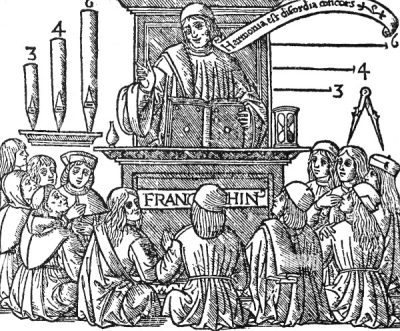Welcome to Renaissance Canons!
We have now 548 canons in our database. Practise them!
.
| During the 16th and 17th centuries, canonical writing and performance in Western European music had several dimensions. With the roots of the imitative texture in the late Medieval era, the canon reached a status of a prolific musical technique during the Renaissance that was explored in formal compositional and improvisational (alla mente) contexts, both from very simple to the most sophisticated uses.
One of the “branches” of the compositional area of canons is based on their use as a didactic tool for learning music theory through aural and vocal approaches. This was a very common method for training young musicians in German-speaking regions influenced by Luther’s Protestant Reformation, lasting until the last decades of the 17th century.
The purpose of this website is to catalogue the didactic canon repertoire published in 16th and 17th-century treatises and organize it from the teaching perspective of the hexachordal music system, going through solmization, modality, mensuration, counterpoint, among other elements.
Following this study, we have also published a new interpretation and a complete edition of Johann Walter’s Sechs und Zwanzig Fugen auff die acht Tonos (1542), a didactic canon collection intended for printing during Walter’s lifetime but that only came to light in the 20th century. |
.
 Gaffurius’ Angelicum ac divinum opus musice (1508) Gaffurius’ Angelicum ac divinum opus musice (1508)
 “Folgen etliche Fugen, in welchen die jungen knaben sönnen geübt werden” “Folgen etliche Fugen, in welchen die jungen knaben sönnen geübt werden”
Zerleder’s Musica figuralis (1658)
|
News:
- 12 canons from Avenarius’ Exercitium dodekatonon (1591) were added to the site. See the Sources section for more details.
.
- The second edition of Beringer’s Musica, das ist die Singkunst (1610) is one of the most prolific printed sources of didactic canons from 16th and 17th centuries. Its 52 canons were added to the site. Sources section for more details.
.
- 17 canons from Gegenbach’s Musica Nova (1626) were added to the site. See the Sources section for more details.
.
- The unique canon published in Holtheuser’s Ein kleine deutsche Musica (1586) was added to the site. See the Sources section for more details.
.
- Quirsfeld’s Breviarium musicum (1675) is one of the most prolific printed sources of didactic canons, which received several editions until 1717. Check out the 46 canons from its 1688 edition we had access. See the Sources section for more details.
.
- 3 canons from Quitschreiber’s Musikbüchlein für die Jugend (1607) were added to the site. See the Sources section for more details.
.
- Older news.
.



